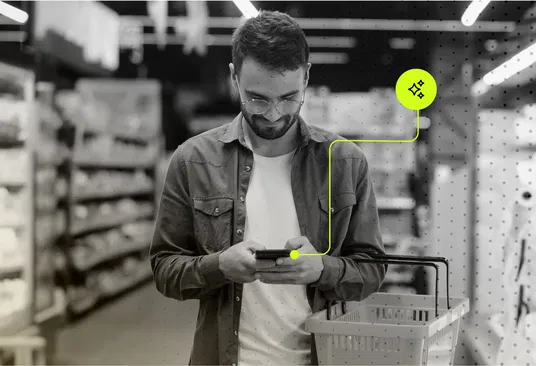Using AI to Power Personalized Shopping in Grocery eCommerce

- The AI Revolution in Grocery Shopping
- AI-Powered Smart Search and Discovery
- Behavior-Based Product Recommendations
- AI Bundle Suggestions Based on Dietary Preferences
- Machine Learning for Pantry Restock Reminders
- AI Chatbot for Grocery Product Discovery
- Behavior-Based Product Feed Customization
- Implementation Strategies for AI-Powered Grocery eCommerce
- Frequently Asked Questions
The AI Revolution in Grocery Shopping
The grocery eCommerce landscape is experiencing a fundamental transformation. With online grocery sales projected to reach $250 billion by 2025, retailers are turning to artificial intelligence to create more personalized, efficient, and engaging shopping experiences.
Modern consumers expect their grocery shopping to be as personalized as their Netflix recommendations or Spotify playlists. They want platforms that understand their dietary preferences, predict their needs, and make shopping effortless. This is where AI-powered personalization becomes not just a competitive advantage, but a necessity.
"AI in grocery eCommerce isn't just about technology—it's about understanding human behavior at scale and creating shopping experiences that feel intuitive and personal." - McKinsey Digital Grocery Report, 2024
AI-Powered Smart Search and Discovery
Traditional keyword-based search falls short in grocery eCommerce. When customers search for "dinner tonight," they're not looking for a specific product—they're expressing an intent that requires intelligent interpretation.
Natural Language Processing in Grocery Search
Advanced AI systems can interpret complex queries like:
- "Quick pasta dinner for 4 people"
- "Gluten-free breakfast options under $20"
- "Ingredients for chicken tikka masala"
- "Healthy snacks for kids' lunchboxes"
These systems use machine learning to understand context, dietary restrictions, family size, and budget constraints, delivering relevant results that traditional search cannot match.
🔍 Semantic Search
Understands meaning behind queries, not just keywords. Connects "heart-healthy" with low-sodium products automatically.
🎯 Intent Recognition
Identifies whether customers are meal planning, restocking, or exploring new products based on search patterns.
Behavior-Based Product Recommendations
The most successful grocery platforms use sophisticated algorithms to analyze customer behavior and predict preferences. This goes far beyond "customers who bought this also bought that."
Multi-Dimensional Recommendation Engines
Modern behavior-based product feed customization in grocery stores considers multiple data points:
- Purchase History: Frequency, seasonality, and brand preferences
- Browsing Behavior: Time spent on categories, abandoned carts, wishlist items
- Demographic Data: Household size, location, age group
- Seasonal Patterns: Holiday shopping, weather-based preferences
- Health Preferences: Organic, low-sodium, diabetic-friendly options
Real-World Impact
Instacart's recommendation engine increased average order value by 23% by suggesting complementary items based on meal context rather than just purchase history.
AI Bundle Suggestions Based on Dietary Preferences
One of the most powerful applications of AI in grocery eCommerce is creating intelligent product bundles that align with customers' dietary needs and preferences. AI bundle suggestions based on dietary preference go beyond simple product groupings to create meaningful meal solutions.
Smart Bundle Creation
AI systems analyze customer profiles to create bundles that consider:
- Dietary Restrictions: Gluten-free, dairy-free, nut allergies
- Lifestyle Choices: Vegan, keto, paleo, Mediterranean
- Health Goals: Weight management, heart-healthy, diabetic-friendly
- Cultural Preferences: Halal, kosher, regional cuisines
- Budget Constraints: Value-conscious vs. premium options
🥗 Meal-Based Bundles
"Mediterranean Dinner for 2" - includes olive oil, fresh herbs, fish, vegetables, and wine pairing suggestions.
🍎 Nutrition-Focused Bundles
"Heart-Healthy Week" - curated selection of omega-3 rich foods, whole grains, and antioxidant-rich produce.
⏰ Time-Saving Bundles
"15-Minute Dinners" - pre-selected ingredients for quick, healthy meals with recipe cards included.
"Personalized bundles increased our average order value by 31% while improving customer satisfaction scores by 18%." - Head of Product, Fresh Direct, 2024
Machine Learning for Pantry Restock Reminders
The holy grail of grocery eCommerce is predicting when customers will run out of products before they realize it themselves. Machine learning for pantry restock reminders uses sophisticated algorithms to analyze consumption patterns and predict replenishment needs.
Predictive Analytics in Action
Advanced systems consider multiple variables:
- Historical Purchase Frequency: How often customers buy specific items
- Seasonal Variations: Increased soup purchases in winter, salad ingredients in summer
- Household Changes: New family members, dietary changes, lifestyle shifts
- Product Characteristics: Shelf life, typical consumption rates, package sizes
- External Factors: Holidays, weather patterns, local events
The Reorder Prediction Engine Based on Meal Cycles
The most sophisticated systems understand that grocery shopping follows meal cycles rather than calendar cycles. A reorder prediction engine based on meal cycles recognizes patterns like:
- Weekly meal prep cycles for busy professionals
- Bi-weekly family shopping patterns
- Monthly bulk purchasing for non-perishables
- Seasonal cooking pattern changes
Implementation Success Story
Amazon Fresh's predictive reordering system achieved 89% accuracy in predicting when customers would run out of frequently purchased items, leading to a 40% increase in subscription-based purchases.
AI Chatbot for Grocery Product Discovery
Modern grocery shoppers often struggle with decision fatigue when faced with thousands of product options. An AI chatbot for grocery product discovery acts as a personal shopping assistant, guiding customers through complex decisions with natural conversation.
Conversational Commerce in Grocery
AI chatbots excel at handling complex grocery queries:
- "I need ingredients for a romantic dinner under $50"
- "What wine pairs well with salmon?"
- "I'm hosting a gluten-free dinner party for 8 people"
- "My toddler is a picky eater - what healthy snacks might they like?"
🤖 Natural Language Understanding
Processes complex requests and asks clarifying questions to narrow down options effectively.
📚 Recipe Integration
Suggests complete ingredient lists for recipes and can modify based on dietary restrictions or preferences.
🛒 Smart Cart Building
Automatically adds suggested items to cart and provides alternatives when preferred brands are unavailable.
The key to successful grocery chatbots is context awareness. They remember previous conversations, understand customer preferences, and can make intelligent substitutions when products are out of stock.
Behavior-Based Product Feed Customization
The homepage and category pages of grocery eCommerce sites are prime real estate. Behavior-based product feed customization in grocery stores ensures that every customer sees a personalized selection of products most relevant to their needs.
Dynamic Feed Optimization
AI systems continuously optimize product feeds based on:
- Time of Day: Breakfast items in the morning, dinner ingredients in the evening
- Day of Week: Weekend meal prep items on Fridays, quick meals on weekdays
- Purchase Timing: Fresh produce reminders, pantry staple restocking
- Browsing History: Categories and brands customers engage with most
- Seasonal Relevance: Holiday ingredients, weather-appropriate foods
Personalization at Scale
Walmart's personalized homepage increased click-through rates by 47% and conversion rates by 23% by showing different product feeds to different customer segments based on their shopping behavior.
Implementation Strategies for AI-Powered Grocery eCommerce
Successfully implementing AI personalization in grocery eCommerce requires a strategic approach that balances technology capabilities with customer experience goals. Here's how leading retailers are approaching this transformation.
Phase 1: Data Foundation
Before implementing AI features, establish a robust data infrastructure:
- Customer Data Platform: Unified view of customer interactions across all touchpoints
- Product Information Management: Rich product data including nutritional information, ingredients, and attributes
- Behavioral Tracking: Comprehensive analytics on browsing, searching, and purchasing patterns
- Inventory Integration: Real-time stock levels and availability data
Phase 2: AI Model Development
Building effective AI models requires specialized expertise in food & beverage eCommerce development:
- Recommendation Algorithms: Collaborative filtering, content-based filtering, and hybrid approaches
- Natural Language Processing: For search understanding and chatbot functionality
- Predictive Analytics: For reorder timing and demand forecasting
- Computer Vision: For product recognition and visual search capabilities
Phase 3: Integration and Testing
Successful AI implementation requires careful integration with existing systems:
🔄 A/B Testing Framework
Continuously test AI recommendations against control groups to measure effectiveness and optimize performance.
📊 Performance Monitoring
Track key metrics like click-through rates, conversion rates, and customer satisfaction scores.
🛡️ Privacy Compliance
Ensure all AI implementations comply with data privacy regulations like GDPR and CCPA.
Common Implementation Pitfalls
- Implementing AI without sufficient data quality and quantity
- Over-personalizing to the point of creating filter bubbles
- Ignoring the importance of explainable AI for customer trust
- Failing to account for seasonal and cultural variations in food preferences
Technology Stack Considerations
Modern grocery eCommerce platforms require sophisticated technology stacks to support AI personalization. Key components include:
- Cloud Infrastructure: Scalable computing resources for machine learning workloads
- Real-time Data Processing: Stream processing for immediate personalization updates
- API-First Architecture: Flexible integration with third-party AI services and tools
- Mobile Optimization: Ensuring AI features work seamlessly across all devices
For retailers looking to implement these advanced features, partnering with specialists in grocery and food eCommerce development can accelerate time-to-market and ensure best practices are followed.
Frequently Asked Questions
1. How accurate are AI-powered reorder predictions?
Leading platforms achieve 85-90% accuracy for frequently purchased items. Accuracy improves over time as the system learns individual consumption patterns. Factors like household changes or dietary shifts can temporarily reduce accuracy until the system adapts.
2. Can AI handle complex dietary restrictions and allergies?
Yes, modern AI systems can manage multiple dietary restrictions simultaneously. They can filter products based on ingredients, certifications, and nutritional content. However, customers with severe allergies should always verify product information independently.
3. How do AI chatbots compare to human customer service for grocery shopping?
AI chatbots excel at product discovery, recipe suggestions, and routine inquiries, available 24/7. They handle 80% of common queries effectively. Complex issues, complaints, or nuanced dietary advice still benefit from human expertise.
4. What data privacy concerns exist with AI personalization?
AI systems collect extensive behavioral and preference data. Reputable platforms use encryption, anonymization, and comply with privacy regulations. Customers should review privacy policies and can typically opt out of data collection while still using basic features.
5. How long does it take to see results from AI implementation?
Basic AI features can show results within 2-3 months. More sophisticated personalization requires 6-12 months to reach full effectiveness as the system learns customer patterns. Continuous optimization is essential for long-term success.
🎯 Key Takeaways
- AI transforms grocery shopping from a chore into a personalized, efficient experience that anticipates customer needs
- Smart search and discovery help customers find products through natural language queries and intent recognition
- Behavior-based recommendations increase average order value by 20-30% while improving customer satisfaction
- Dietary preference-based bundles simplify meal planning and introduce customers to new products
- Predictive reordering based on consumption patterns reduces customer effort and increases loyalty
- AI chatbots provide 24/7 shopping assistance and handle 80% of common customer queries
- Personalized product feeds ensure customers see the most relevant items at the right time
- Implementation success requires strong data foundations, specialized expertise, and continuous optimization
Ready to Choose the Right Development Partner?
Implementing AI-powered personalization in grocery eCommerce requires deep expertise in both artificial intelligence and food retail dynamics. Our team specializes in creating intelligent grocery platforms that drive engagement, increase sales, and delight customers.
From predictive analytics to conversational commerce, we help grocery retailers leverage cutting-edge AI technology to stay competitive in the digital marketplace.
About 1Center
1Center is a leading eCommerce development agency specializing in AI-powered retail solutions. With over 8 years of experience in grocery and food & beverage eCommerce, we've helped dozens of retailers implement sophisticated personalization systems that drive measurable results.
Our expertise spans the entire technology stack, from machine learning algorithms to user experience design. We understand the unique challenges of grocery eCommerce, including complex inventory management, perishable goods logistics, and diverse dietary requirements.
Whether you're launching a new grocery platform or enhancing an existing one with AI capabilities, our team provides the strategic guidance and technical expertise needed for success.
Written byPublished June 30, 2025
1Center


